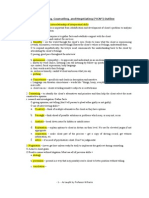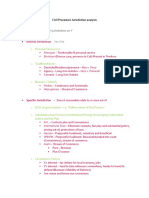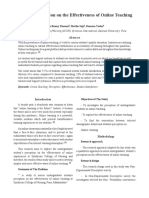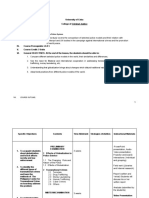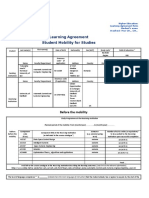0 ratings0% found this document useful (0 votes)
479 views2016 Oral Argument Scoring Rubric 1
2016 Oral Argument Scoring Rubric 1
Uploaded by
Rhem Rick CorpuzThe document provides an oral argument scoring sheet for judges to evaluate competitors in a moot court competition. It includes criteria in five areas: opening statement, presentation of the merits, questions from the court, demeanor, and closing/rebuttal. Judges are asked to assign scores from 50 to 100 based on the quality of presentation for each criteria, including the competitor's organization, persuasiveness, understanding of legal issues, and ability to answer questions. The scoring sheet will be used to determine which competitors advance to the next round.
Copyright:
© All Rights Reserved
Available Formats
Download as PDF, TXT or read online from Scribd
2016 Oral Argument Scoring Rubric 1
2016 Oral Argument Scoring Rubric 1
Uploaded by
Rhem Rick Corpuz0 ratings0% found this document useful (0 votes)
479 views1 pageThe document provides an oral argument scoring sheet for judges to evaluate competitors in a moot court competition. It includes criteria in five areas: opening statement, presentation of the merits, questions from the court, demeanor, and closing/rebuttal. Judges are asked to assign scores from 50 to 100 based on the quality of presentation for each criteria, including the competitor's organization, persuasiveness, understanding of legal issues, and ability to answer questions. The scoring sheet will be used to determine which competitors advance to the next round.
Original Description:
For those taking up moot court subjects.
Original Title
2016-Oral-Argument-Scoring-Rubric-1
Copyright
© © All Rights Reserved
Available Formats
PDF, TXT or read online from Scribd
Share this document
Did you find this document useful?
Is this content inappropriate?
The document provides an oral argument scoring sheet for judges to evaluate competitors in a moot court competition. It includes criteria in five areas: opening statement, presentation of the merits, questions from the court, demeanor, and closing/rebuttal. Judges are asked to assign scores from 50 to 100 based on the quality of presentation for each criteria, including the competitor's organization, persuasiveness, understanding of legal issues, and ability to answer questions. The scoring sheet will be used to determine which competitors advance to the next round.
Copyright:
© All Rights Reserved
Available Formats
Download as PDF, TXT or read online from Scribd
Download as pdf or txt
0 ratings0% found this document useful (0 votes)
479 views1 page2016 Oral Argument Scoring Rubric 1
2016 Oral Argument Scoring Rubric 1
Uploaded by
Rhem Rick CorpuzThe document provides an oral argument scoring sheet for judges to evaluate competitors in a moot court competition. It includes criteria in five areas: opening statement, presentation of the merits, questions from the court, demeanor, and closing/rebuttal. Judges are asked to assign scores from 50 to 100 based on the quality of presentation for each criteria, including the competitor's organization, persuasiveness, understanding of legal issues, and ability to answer questions. The scoring sheet will be used to determine which competitors advance to the next round.
Copyright:
© All Rights Reserved
Available Formats
Download as PDF, TXT or read online from Scribd
Download as pdf or txt
You are on page 1of 1
2016 James Patterson McBaine Honors Moot Court Competition
ORAL ARGUMENT SCORING SHEET
Judge’s Name:
Competitor’s Name:
Please assign specific scores within the ranges below (The lowest score is 50 and the highest score is 100).
Please score the arguments based on the quality of presentation, not on the actual merits of the case.
This evaluation will not be distributed to competitors. It will be used solely to determine which
competitors will advance to the next round.
Very
CRITERIA Poor Fair Good Good Excellent SCORE
Opening Statement
• Proper statement of purpose of the appeal 8 9-10 11-12 13-14 15
• Quick summary of party’s basic position
• Proper presentation of weakness of case from 15 pts
decisions below max.
• Reading from prepared statement vs. natural
command of the case
• Proper tone
Presentation of the merits
• Coherence and clarity of argument
• Organization 15-17 18-20 21-24 25-27 28-30
• Reasoned arguments with proper analysis and
conclusions
• Persuasive theme 30 pts.
• Understanding of legal issues max.
• Proper focus on important issues of case
• Use of legal authority or policy arguments
• Familiarity with the record
• Logical ordering of argument and effective
use of time
Questions from the Court
• Ability to answer questions (i.e., not surprised 18-21 22-25 26-27 28-31 32-35
by questions)
• Responsiveness to questions
35 pts.
• Persuasiveness
• Use of questions to advance client’s position
max.
• Handling of weaknesses of case
• Continuation of argument after answering
questions
Demeanor
• Confidence 8 9-10 11-12 13-14 15
• Preparation—ready to answer questions
• Quality of delivery (natural, relaxed presence, 15 pts.
projection, poise and appearance)
• Voice (i.e., not monotonous)
max.
• Proper tone (i.e., not sarcastic or disrespectful)
• Body language
• Eye contact
Closing (and Rebuttal)
• Proper closing using the actual argument vs. a 1 2 3 4 5 5 pts.
prepared statement
• Proper rebuttal capitalizing on Respondent’s
max.
weaknesses and questions from the Court
Total
You might also like
- Mpre Ope 1Document61 pagesMpre Ope 1Julie DnqNo ratings yet
- Bench Memo On Laser EvidenceDocument8 pagesBench Memo On Laser EvidencePaul GowderNo ratings yet
- New York Family Law Guide 2012Document12 pagesNew York Family Law Guide 2012eyall8855No ratings yet
- Quiz 5 (MCQ)Document3 pagesQuiz 5 (MCQ)wendelNo ratings yet
- Scott Lamb vs. Liberty University LawsuitDocument9 pagesScott Lamb vs. Liberty University LawsuitDavid CrossNo ratings yet
- MRPC RulesDocument189 pagesMRPC RulesHaifaNo ratings yet
- Civil Procedure Checklist - NoticeDocument7 pagesCivil Procedure Checklist - Noticeharrier666No ratings yet
- Character Evidence OutlineDocument6 pagesCharacter Evidence Outlinermpdesign1No ratings yet
- Crim OutlineDocument62 pagesCrim Outlinegialight100% (1)
- Charles K. Burdick Origins Part I Columbia Law Review 1911Document19 pagesCharles K. Burdick Origins Part I Columbia Law Review 1911kurtnewmanNo ratings yet
- Criminal Law OutlineDocument25 pagesCriminal Law OutlinechristiandemeNo ratings yet
- Rosenbaum FrankfordDocument334 pagesRosenbaum FrankfordJorge Luis Rivera AgostoNo ratings yet
- Intro. To Criminology (Module 1)Document71 pagesIntro. To Criminology (Module 1)Rhem Rick Corpuz100% (4)
- Japanese Police System: By: Alexander L. ZapantaDocument13 pagesJapanese Police System: By: Alexander L. ZapantaRhem Rick Corpuz100% (1)
- STARTFIRE SF 2100C ManualDocument63 pagesSTARTFIRE SF 2100C ManualKarthick MNo ratings yet
- CH 1 Partnership MM oDocument4 pagesCH 1 Partnership MM osomeguy813No ratings yet
- Civ Pro 2 Worksheet 5Document6 pagesCiv Pro 2 Worksheet 5Victor MastromarcoNo ratings yet
- San Antonio Independent School District v. Rodriguez Case BriefDocument4 pagesSan Antonio Independent School District v. Rodriguez Case BriefAnkit Tiwari100% (1)
- Ch05 - Antitakeover MeasuresDocument57 pagesCh05 - Antitakeover MeasuresAnh Lý50% (2)
- Community PropertyDocument2 pagesCommunity Propertyjm9887No ratings yet
- Incruises Compensation Plan Overview Brochure Letter enDocument28 pagesIncruises Compensation Plan Overview Brochure Letter enmiguel100% (1)
- Negotiation & ADR: Prof. John Barkai William S. Richardson School of Law University of HawaiiDocument144 pagesNegotiation & ADR: Prof. John Barkai William S. Richardson School of Law University of HawaiiMohd Shahlan Sidi AhmadNo ratings yet
- Using Point Headings To Make A PointDocument2 pagesUsing Point Headings To Make A PointGregory BerryNo ratings yet
- Evidence Outline 2013Document34 pagesEvidence Outline 2013cpulver7947100% (1)
- Professional Responsibility Exam Outline 2006 (MN)Document21 pagesProfessional Responsibility Exam Outline 2006 (MN)jarabboNo ratings yet
- IL Civ Pro Bar OutlineDocument6 pagesIL Civ Pro Bar OutlineJohn RisvoldNo ratings yet
- Legal Ethics ArticleDocument61 pagesLegal Ethics ArticleChrizie A. Leynes100% (1)
- Professional Responsibility Gillers Fall 2009Document32 pagesProfessional Responsibility Gillers Fall 2009gtownhopefu2013100% (2)
- Legal Letters OutlineDocument29 pagesLegal Letters Outlinetconn8276No ratings yet
- Pers JRD FlowchartDocument1 pagePers JRD FlowchartpromogoatNo ratings yet
- Civil Procedure JurisdictionDocument2 pagesCivil Procedure Jurisdictionlsathater100% (2)
- Lopez Contracts OutlineDocument65 pagesLopez Contracts Outlinewil lopezNo ratings yet
- Civil ProcedureDocument2 pagesCivil Proceduretyler100% (1)
- Classification of Remedies (Outline)Document4 pagesClassification of Remedies (Outline)Ronnie Barcena Jr.No ratings yet
- Property Law - Dukeminier Chap2C - Gifts - PPDocument8 pagesProperty Law - Dukeminier Chap2C - Gifts - PPRuchika BenganiNo ratings yet
- Enghish VocabularDocument13 pagesEnghish VocabularSandra BarNo ratings yet
- Final Civil Procedure Outline!Document7 pagesFinal Civil Procedure Outline!Kate BroderickNo ratings yet
- JSR Civ Pro 2018 Review SessionDocument46 pagesJSR Civ Pro 2018 Review SessionJames BondNo ratings yet
- Evidence II Mentor OutlineDocument10 pagesEvidence II Mentor OutlineLALA100% (1)
- Con Law - Outline 2Document51 pagesCon Law - Outline 2Justin Bouchard100% (1)
- Evidence OutlineDocument15 pagesEvidence OutlineNuominNo ratings yet
- Torts MBE Workshop ReviewDocument4 pagesTorts MBE Workshop ReviewSophia HepheastouNo ratings yet
- Writing SkillsDocument10 pagesWriting Skillsca1robby15No ratings yet
- Oral Argument PPT - STDocument28 pagesOral Argument PPT - STAnirudh VadlamaniNo ratings yet
- Discovery OutlineDocument3 pagesDiscovery Outlinetzq3No ratings yet
- Ivil Rocedure: Ersonal Urisdiction HO CAN BE SuedDocument45 pagesIvil Rocedure: Ersonal Urisdiction HO CAN BE SuedVicki GokhmanNo ratings yet
- $6Wxghqw V Xlghwr&Dvh%Ulhilqj: The Case Method: in First-Year Law Courses, Professors Typically DoDocument4 pages$6Wxghqw V Xlghwr&Dvh%Ulhilqj: The Case Method: in First-Year Law Courses, Professors Typically DoLeizza Ni Gui Dula100% (1)
- Evidence Cheat Sheet - FinalDocument2 pagesEvidence Cheat Sheet - FinalkevinlsouthernNo ratings yet
- Ethics OutlineDocument35 pagesEthics OutlinePaul UlitskyNo ratings yet
- Appellate Brief - Oral Presentation ChecklistDocument2 pagesAppellate Brief - Oral Presentation ChecklistAgguy7No ratings yet
- CharacterDocument15 pagesCharacterZarah TrinhNo ratings yet
- Outline - Agency & PartnershipDocument19 pagesOutline - Agency & PartnershipSaulNo ratings yet
- Admin Quiz PrepDocument3 pagesAdmin Quiz PrepCasey MillerNo ratings yet
- Copyright Litigation Handbook - Contents and Overview - Raymond J. DowdDocument24 pagesCopyright Litigation Handbook - Contents and Overview - Raymond J. DowdRay Dowd0% (1)
- Con Law - BlackDocument63 pagesCon Law - Blackelleeklein100% (1)
- Corporate Responsibility and Human Rights Global Trends and Issues Concerning Indigenous Peoples Jide James-EluyodeDocument52 pagesCorporate Responsibility and Human Rights Global Trends and Issues Concerning Indigenous Peoples Jide James-Eluyodepraidoluoma100% (7)
- K BarExamS10Document2 pagesK BarExamS10zzsquadronNo ratings yet
- OutlineDocument109 pagesOutlineBryan PriceNo ratings yet
- Professional Responsibility MaymesterDocument64 pagesProfessional Responsibility MaymesterSierra Childers0% (1)
- Petitioner's Motion To CompelDocument18 pagesPetitioner's Motion To CompelSamuel RichardsonNo ratings yet
- Law of Torts Final DraftDocument24 pagesLaw of Torts Final DraftMandira PrakashNo ratings yet
- Amici Brief Revised CoverDocument47 pagesAmici Brief Revised CoverDuncan100% (1)
- Nino - Research ProposalDocument16 pagesNino - Research ProposalRhem Rick CorpuzNo ratings yet
- Students Perception On The Effectiveness of Online TeachingDocument9 pagesStudents Perception On The Effectiveness of Online TeachingRhem Rick CorpuzNo ratings yet
- The Effectiveness of Using Mobile Learning Techniques To Improve Learning Outcomes in Higher EducationDocument15 pagesThe Effectiveness of Using Mobile Learning Techniques To Improve Learning Outcomes in Higher EducationRhem Rick CorpuzNo ratings yet
- Self-Reported Effectiveness of E-Learning Classes During COVID-19 Pandemic: A Nation-Wide Survey of Pakistani Undergraduate Dentistry StudentsDocument10 pagesSelf-Reported Effectiveness of E-Learning Classes During COVID-19 Pandemic: A Nation-Wide Survey of Pakistani Undergraduate Dentistry StudentsRhem Rick CorpuzNo ratings yet
- Paper Odl PandemicDocument14 pagesPaper Odl PandemicRhem Rick CorpuzNo ratings yet
- Philosophy of Punishment in Criminology: A Historical ReviewDocument18 pagesPhilosophy of Punishment in Criminology: A Historical ReviewRhem Rick CorpuzNo ratings yet
- Criminal Law Module 2Document52 pagesCriminal Law Module 2Rhem Rick CorpuzNo ratings yet
- Deconstructing The Relationship Between Entrepreneurial Orientation and Business Performance at The Embryonic Stage of Firm GrowthDocument11 pagesDeconstructing The Relationship Between Entrepreneurial Orientation and Business Performance at The Embryonic Stage of Firm GrowthRhem Rick CorpuzNo ratings yet
- Job Satisfaction of Police Officers During Covid-19 PandemicDocument100 pagesJob Satisfaction of Police Officers During Covid-19 PandemicRhem Rick CorpuzNo ratings yet
- Sample Format of After Operation ReportDocument4 pagesSample Format of After Operation ReportRhem Rick Corpuz100% (1)
- An OverviewDocument9 pagesAn OverviewRhem Rick CorpuzNo ratings yet
- Afghanistan Bangladesh Bhutan Cambodia India Indonesia Malaysia Maldives Nepal PakistanDocument2 pagesAfghanistan Bangladesh Bhutan Cambodia India Indonesia Malaysia Maldives Nepal PakistanRhem Rick CorpuzNo ratings yet
- COMPARATIVE POLICE SYSTEM SUMMER (Repaired)Document168 pagesCOMPARATIVE POLICE SYSTEM SUMMER (Repaired)Rhem Rick CorpuzNo ratings yet
- Criminal Justice Centralization Versus Decentralization in The Republic of ChinaDocument12 pagesCriminal Justice Centralization Versus Decentralization in The Republic of ChinaRhem Rick CorpuzNo ratings yet
- Comparative Police System SummerDocument190 pagesComparative Police System SummerRhem Rick Corpuz100% (1)
- Comparative Police System Syllabus FinaleDocument5 pagesComparative Police System Syllabus FinaleRhem Rick Corpuz0% (1)
- About Interpol: 188 Member CountriesDocument27 pagesAbout Interpol: 188 Member CountriesRhem Rick CorpuzNo ratings yet
- Australian Federal PoliceDocument24 pagesAustralian Federal PoliceRhem Rick Corpuz0% (2)
- 30th ASEANAPOL Conference Focus On Harmonization in RegionDocument1 page30th ASEANAPOL Conference Focus On Harmonization in RegionRhem Rick CorpuzNo ratings yet
- INTERPOL and PNPDocument56 pagesINTERPOL and PNPRhem Rick CorpuzNo ratings yet
- Business Ethics As Competitive Advantage For Companies in The Globalization EraDocument17 pagesBusiness Ethics As Competitive Advantage For Companies in The Globalization EraRhem Rick CorpuzNo ratings yet
- 5487 RVWDocument125 pages5487 RVWRhem Rick CorpuzNo ratings yet
- COMMON INVESTIGATION OVERSIGHTS ADocument2 pagesCOMMON INVESTIGATION OVERSIGHTS ARhem Rick Corpuz100% (1)
- The Role of Theory in ResearchDocument12 pagesThe Role of Theory in ResearchRhem Rick CorpuzNo ratings yet
- La Uk Sheffie01 Cti An3Document6 pagesLa Uk Sheffie01 Cti An3tutuN_No ratings yet
- The Examination of The Trait-Anger Level of The University Students According To The WellnessDocument7 pagesThe Examination of The Trait-Anger Level of The University Students According To The WellnessNiharika shuklaNo ratings yet
- PT706 Lecturer 3Document13 pagesPT706 Lecturer 3wenano496No ratings yet
- A Dynamic Method Based On The Specific Substrate Uptake Rate To Set Up A Feeding Strategy For Pichia PastorisDocument9 pagesA Dynamic Method Based On The Specific Substrate Uptake Rate To Set Up A Feeding Strategy For Pichia PastorisOscar Evrard ArruéNo ratings yet
- 2021 Book UncertaintyInMechanicalEngineeDocument313 pages2021 Book UncertaintyInMechanicalEngineeMark Louie Guinto100% (2)
- How Judaism Predicted The First Humanoid Robot - CNN Belief Blog - CNN - Com BlogsDocument25 pagesHow Judaism Predicted The First Humanoid Robot - CNN Belief Blog - CNN - Com BlogsShmaiaNo ratings yet
- General SupplementDocument24 pagesGeneral Supplementmuralimohanrao rojukurthiNo ratings yet
- Adobe Scan 13-Apr-2024Document2 pagesAdobe Scan 13-Apr-2024nakshvij351No ratings yet
- ĐỀ THI THỬ HSG 11- N0 4Document9 pagesĐỀ THI THỬ HSG 11- N0 4Đức THNo ratings yet
- Econometrics MidDocument3 pagesEconometrics Midalexanderzewdu7No ratings yet
- Practice Makes Permanent: Barbara Oakley, PHD, PeDocument12 pagesPractice Makes Permanent: Barbara Oakley, PHD, PeAlex LipoNo ratings yet
- Problem and Review of Literature: Surigao Del Norte National High School Peñaranda ST., Surigao CityDocument40 pagesProblem and Review of Literature: Surigao Del Norte National High School Peñaranda ST., Surigao Cityaye plazaNo ratings yet
- Deliverables For Pre-Final Thesis ReportDocument19 pagesDeliverables For Pre-Final Thesis ReportmonikaNo ratings yet
- Biology IMPDocument5 pagesBiology IMPYash MaliNo ratings yet
- The NCI Thesaurus & TDEDocument9 pagesThe NCI Thesaurus & TDESbo ChenNo ratings yet
- Team Building Project ReportDocument3 pagesTeam Building Project Reportshweta joshiNo ratings yet
- IRC-123-2017 Geophysical Investigation For BridgesDocument68 pagesIRC-123-2017 Geophysical Investigation For BridgesZakee MohamedNo ratings yet
- Reservoir Inflow Performance: PET-332 E Production Engineering & Surface FacilitiesDocument35 pagesReservoir Inflow Performance: PET-332 E Production Engineering & Surface Facilities000No ratings yet
- ANSWERSDocument1 pageANSWERSeneaskNo ratings yet
- REACH Regulation and Substances in ArticlesDocument2 pagesREACH Regulation and Substances in ArticlesEric ChanNo ratings yet
- Math 10 q4 M2Document7 pagesMath 10 q4 M2Elgin PagariganNo ratings yet
- PHD Thesis Using Exploratory Factor AnalysisDocument8 pagesPHD Thesis Using Exploratory Factor Analysiskatrinaduartetulsa100% (2)
- 38-37-1-PB Vitaminas LiposolublesDocument6 pages38-37-1-PB Vitaminas Liposolubleslaboratorio fisicoquimicoNo ratings yet
- Mapua University: Experiment No. 3.B Hydrometer Analysis of SoilDocument9 pagesMapua University: Experiment No. 3.B Hydrometer Analysis of SoilMike SyNo ratings yet
- Btech Cse CC 2021rDocument5 pagesBtech Cse CC 2021rDevish MittalNo ratings yet
- Aplisens PEM-1000Document4 pagesAplisens PEM-1000CalcRodVerNo ratings yet
- NCERT Solutions For Class 9 English Feb 13 Beehive Chapter 3 The Little GirlDocument6 pagesNCERT Solutions For Class 9 English Feb 13 Beehive Chapter 3 The Little GirlSai KaushalNo ratings yet
- Humour AestheticsDocument14 pagesHumour AestheticsAdriana CajvanNo ratings yet
- Assessment of Noise Temperature Light Intensity AnDocument7 pagesAssessment of Noise Temperature Light Intensity AnAmal Kanti DebNo ratings yet




























